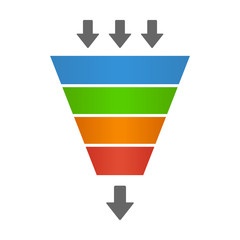It is Time to Create a Sales Funnel to Close Deal after Deal
One of the most interesting aspects of the work I do in the area of Strategic Business Selling™ (sales  training that transforms the commercial organization by moving from traditional sales training to training that is based on using business acumen to develop and present solutions to the customer that helps their bottom line) is sitting in strategic account reviews and listening to the progress being made - or in a couple of cases last week - the lack of progress being made delivering the right value proposition to the right customers to generate profitable account revenue. In the accounts where the sales team is experiencing stalled sales deals, the one thing they do seem to be doing well is making a lot of excuses.
training that transforms the commercial organization by moving from traditional sales training to training that is based on using business acumen to develop and present solutions to the customer that helps their bottom line) is sitting in strategic account reviews and listening to the progress being made - or in a couple of cases last week - the lack of progress being made delivering the right value proposition to the right customers to generate profitable account revenue. In the accounts where the sales team is experiencing stalled sales deals, the one thing they do seem to be doing well is making a lot of excuses.
Listening to the excuses of the underperforming sales professionals last week was almost comical and included “customers being on vacation”, “geopolitical issues getting in the way of closing deals”, “marketing clutter getting in the way”, and the good old “I have no idea what’s going on, we are just playing the waiting game.”
The waiting game in 2017? I don’t think that can be a valid excuse any longer. We are living in an “always on” world where there are limitless ways of staying connected and limitless opportunities for developing and growing the business. In other words, if you are a sales professional, you should never be in “waiting game mode.” Instead, I say reverse the tables and create a sales funnel where you are never waiting, only closing deal after deal.
I share this perspective based on one critical premise; if you are playing the “waiting game” then you simply aren’t busy enough. And if you aren’t busy enough and say you don’t have enough accounts, then you can stop reading this blog and go back to your nap.
Assuming you are still reading, then let’s talk about the strategic business selling sales process. If you have the right mix of prospecting, nurturing, proposing, closing, and growing, then you should always be busy and always looking at that portfolio and prioritizing your time to focus on the deals that are the most profitable or have the most future revenue potential. A top performing sales professional should be working at least 60 productive hours a week spreading the work effort between the different elements of the process.
Planning the Process and Balancing Your Time
The strategic business selling process is based on effectively planning your time. To do that, let’s think about the elements of time we already know:
- Your Sales Cycle Time
- The time it takes to conduct a great sales meeting
- The time it takes to build a proposal
- The time it takes to develop and negotiate a contract
- The time it takes to implement your solution
- The time it takes to check-in with the customer and look for new opportunities
Notice there is no bullet that says “waiting game”…
The secret to long term sales success and the ability to avoid the waiting game is to integrate your 60 hours of productive work a week with the sales cycles and the balance of effort below.
Depending upon your goals and experience level, you will allocate your time in the five buckets. Let’s assume that you consistently know where 60% of your sales target is coming from and you are always looking for that next 40%. Your time should be allocated this following way:
- Prospecting – 30%
- Nurturing – 25%
- Proposing – 10%
- Closing – 10%
- Growing – 25%
I propose that if you follow this suggested approach you will never have to be sitting around waiting; you will always be proactively driving your own sales funnel, portfolio, and cycle of productivity.




